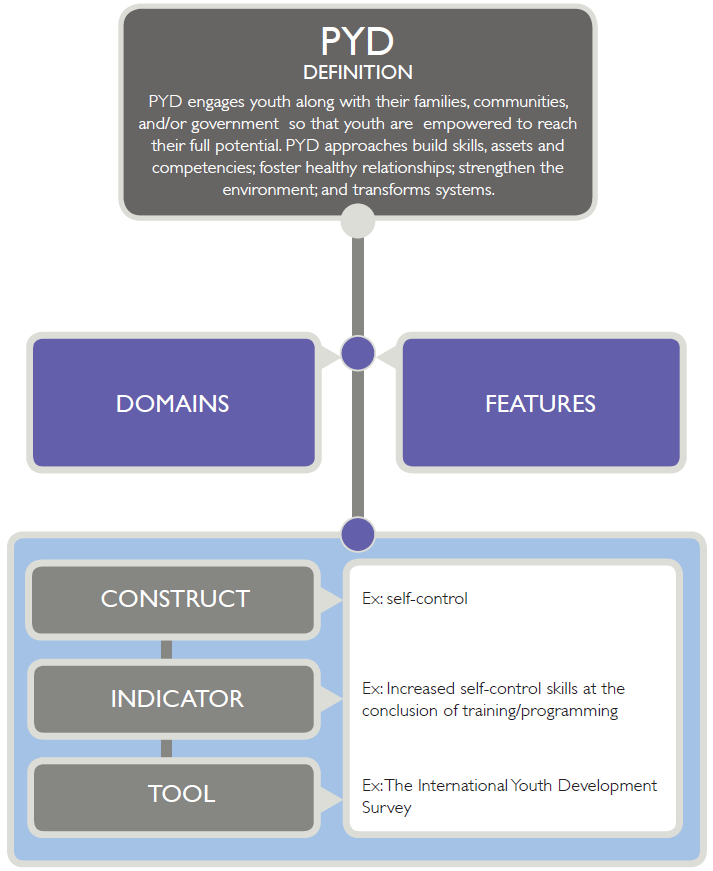From the PYD Framework to Measuring Core PYD Constructs
The PYD domains and features described in the previous chapter include important concepts such as life skills, engagement and bonding. Because these concepts are essential to the PYD Framework, it is important to monitor and evaluate them in the course of program development and implementation. These central concepts are referred to as “constructs” because they can be measured in a variety of ways rather than only one direct way. To effectively measure PYD outcomes, indicators should be selected that are practical to measure and pertain as directly as possible to the PYD concepts the program addresses.
This section provides a brief description of the process for selecting indicators to measure PYD constructs, and then describes ways to apply the PYD Framework at each phase of a program design and evaluation, including examples drawn from a case study of a PYD program.
The figure below visualizes the relationship among the PYD definition, domains and features, and terminology associated with measurement used in this toolkit.
 For this PYD Measurement Toolkit, the YouthPower Learning Team selected core PYD constructs, corresponding illustrative indicators, and sources (tools) for measuring the indicators.
For this PYD Measurement Toolkit, the YouthPower Learning Team selected core PYD constructs, corresponding illustrative indicators, and sources (tools) for measuring the indicators.
These links provide the following resources:
• The PYD Illustrative Indicators Table (Annex E in the printed document) includes the list of PYD illustrative indicators, organized within the domain by the PYD feature, construct and definition. The indicators in this toolkit are illustrative, and not all will apply to any given program. They do not represent an exhaustive set of all indicators associated with PYD, but rather a subset of indicators associated with core PYD constructs that are relevant to programs in LMICs.
• Reference Sheets (Annex F in the printed document) for each measurement source for indicators listed in the PYD Illustrative Indicators Table. Reference sheets contain information such as the citation for the source, a brief description, target age group for the tool, and the relevant tool items that link to the illustrative indicators. Note that the measurement sources have only been validated in the specified countries listed. Further validation of measures in other countries not listed is strongly recommended.
• PYD Measurement Sources Table (Annex G in the printed document): shows which indicators map to which sources. To the extent possible, the YouthPower Learning Team selected measurement sources for the indicators that were relatively low in cost, easy to use, had good evidence of reliability and validity, and either had already been used in the international context or had potential to be used in developing countries.
How to Use the PYD Illustrative Indicators
The indicators included within this toolkit are designed to be used across multiple sectors and a variety of programs for youth, from sexual and reproductive health to democracy and governance. Often, these PYD indicators serve as intermediate indicators, linking activities from a PYD program to long-term outcomes in specific sectors, such as workforce development and democracy and governance. Two youth-specific Foreign Assistance Indicators (also called “F-indicators”), which are mandatory in USAID programs, and two pilot USAID youth indicators are also included within this toolkit.
Most of the selected illustrative indicators are designed to track change in PYD constructs and generally should be measured pre-intervention, immediately post-intervention and at future follow-ups (e.g. 3 months, 6 months, 1 and 2 years, or longer) depending on the funds and project life span.
While research shows that using PYD leads to improved outcomes in health and other areas (see Annex D for background on PYD), more research on PYD effectiveness in LMICs is needed. Use of these indicators in LMICs can provide additional data on how PYD approaches and outcomes can be linked to sector-specific outcomes. For example, by collecting PYD indicators that measure developmental outcomes for youth, evaluators may be able to show that select program activities lead to increased self-efficacy (a PYD construct), which in turn leads to increases in condom use (a health sector-specific outcome). PYD-related outcomes may be the primary outcome of interest for some programs. For instance, increasing self-efficacy among adolescent girls might be the goal of a youth program.







